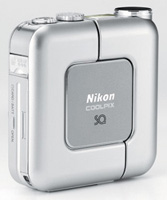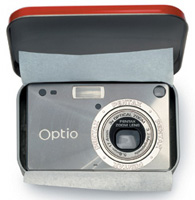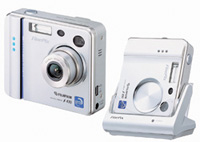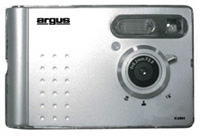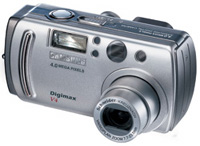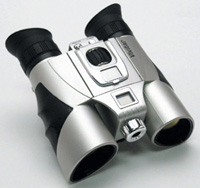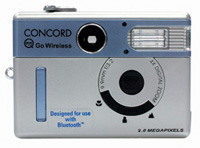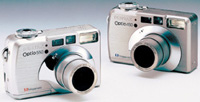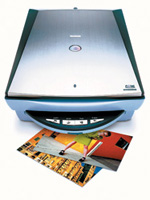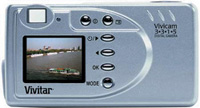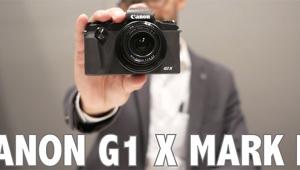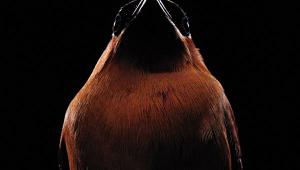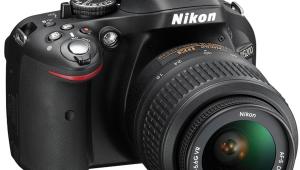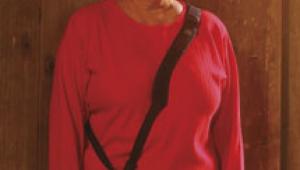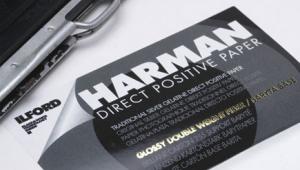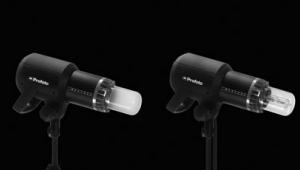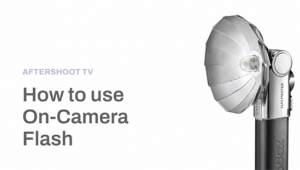The Digital Doing At PMA
Digicams, Printers And Scanners A Plenty
| This year's PMA Show posed a number of cliché-ridden questions about the present and future of digital imaging: "Are all pixels equal?" was something Foveon asked last year. But the big question this year was surely "Does size matter?" Half A Chip Is Better
Than None |
|
The Earnest E. Mau
Memorial Award |
|
The third-nominated Pentax Optio S is so small (How small is it?) that it fits inside an empty Altoids can! Although debuting at the International Consumer Electronics Show in January, PMA was the first time the photographic trade got a peek at the 3.2-megapixel Optio S. The face of the Optio S is smaller than an average credit or business card, just over 3/4 of an inch thick, and has a 3x (12x when combined with the mostly useless digital zoom capability) zoom wrapped around a sleek aluminum alloy body. The Optio S' sliding lens mechanism allows the camera's 3x optical lens to fully recede into the camera housing, flush with the body. The camera includes features found only on larger models, including movie mode, voice recording, and a well-placed 1.6" LCD preview panel. Although the Optio S is small, even a big guy like me will find it easy to make photos. Unlike some other boutique designs the Pentax Optio S is being shipped to major camera retailers and should be available by the time you read this. |
|
Casio showed an entire class
of card-sized Exilim (I know, it's as dumb a made-up name as Dimâge)
cameras that deserves to be nominated but I selected the CES-introduced
Exilim EX-S3. It combines 3.2 megapixels with a 2.0" LCD monitor
screen and wraps it in a .46" thick Porsche-like design. The case
is made of lightweight magnesium alloy, with a body that weighs a mere
2.54 oz (without battery), all for a mere $349.99. |
|
Argus offers a fashion accessory
called the SL2800 (rolls off the tongue doesn't it?) but looks like
it should be under glass at Cartier's. It's as thin as my
wallet after trying to win a H2 Hummer by playing dollar slots in the
casinos, thanks in part to a lack of LCD preview panel. (If you absolutely,
positively must have a preview panel get the slightly more expensive--and
thicker--SL2820.) Argus showed me a sexy mother-of-pearl version.
The 2-megapixel SL2800 delivers 1600x1200 pixels so digi-snobs might pass
it by, but those who know that your camera says as much about you as the
kind of car you drive will want one, especially with a price tag that's
less than $200. Trendsetting Digicams |
|
Samsung's new
V Series includes the 4-megapixel Digimax V4 and Digimax |
|
Canon gets it. Their new PowerShot
S50 is a 5-megapixel digital camera that features a high-resolution 3x
f/2.8 optical zoom lens together with a compact, cool-looking black brushed
aluminum alloy exterior. The S50, like all of Canon's new digicams,
including the insanely cool 10D, includes Canon's DIGIC Imaging
Processor with iSAPS (Intelligent Scene Analysis based on Photographic
Space, aren't you glad to know that?) technology to provide enhanced
image quality, and increased processing speed. Other features include
a nine-point autofocus system for faster and easier focusing; nine-position
White Balance; selectable metering modes for precise exposure in almost
any shooting condition; selectable Second-Curtain sync flash; an improved
Movie Mode that captures clips up to three minutes apiece with sound;
and Direct Print capabilities with Canon's Card Printer CP-100 dye
sublimation printer and several Canon Bubble Jet Direct printers. The
PowerShot S50 has a suggested price of $699. |
|
Looking more like Luke Skywalker's
digital binoculars in Episode 4 than the any knock-off found at SciFi
conventions, Vivitar's Binocam is a set of compact binoculars with
built-in digital camera. Ideal for birdwatchers (or busybodies) who need
a 10x magnification binocular with the added benefit of being able to
transfer still images or movie clips to your computer. Center focus with
an individual right eyepiece adjustment allows the user to easily compensate
for vision differences, while the compact 25mm objective lens keeps the
size small enough to use at a concert or on the trail. The digital function
offers VGA 640x480 resolution, 8MB of built-in memory, 10-second video
clip capability, self-timer, auto White Balance, LCD status display, and
a USB cable interface. The suggested retail price for the Binocam binoculars
is $91.95. |
|
And finally, the biggest surprise of the show was the LS633 from Kodak. Oh sure, it looks nice and has a 3x Schneider-Kreuznach Variogon lens, delivers 3-megapixel resolution images, and features the ruby-red Share button that will be on every new Kodak camera hereafter. It's a nice little camera but its most important feature is the OLED (Organic Light Emitting Diode) screen that changes the playing field for every amateur or professional digital camera from this day on. At 2.2" the screen is large, but more importantly is richly saturated and can be viewed through 165Þ of camera tilt or direction. After today, nobody will want any camera without an OLED screen and Kodak has formed a new division to market the technology to the world. OLED might be the secret weapon that saves Eastman Kodak from oblivion. If that's not enough, the LS633 is available with an optional dock that lets you make 4x6 borderless dye sublimation prints without requiring a separate printer. This is the best solution from beginning to end ever delivered by Kodak, maybe by anybody, but Eastman Kodak must remain true to its idiosyncratic self and the LS633 will (initially) only be available in Europe, Asia, and Australia. When asked when the camera would be available in North America a Kodak spokesperson told me, "We do not have a date for US availability." Point And Just Shoot
Me II: The Sequel |
|
Rollei's d210 motion offers 2.1 megapixels, movie mode, and manual control for creative picture making. It's fitted with an f/2.8-5.6 D-Rolleigon lens. The mostly useless 2x digital zoom can be used both for shooting and during playback. The focusing range lies between 2.25 ft and infinity, macro focusing between 11.8 and 31.5". Shutter speeds range from 1/2 to 1/500 sec. White Balance settings include Auto, Sun, Shade, Tungsten, and Fluorescent, and the built-in flash offers Auto, Fill-in, Off, and Redeye Reduction settings. Camera settings are displayed on an LCD and 1.6" TFT color preview panel. Still images are recorded in JPEG, EXIF, and DPOF formats, video clips in AVI Motion (M-JPEG), either in the camera's 8MB internal memory or an SD card. The camera has a USB interface and video output that can toggle between NTSC and PAL. |
|
Toshiba's PDR-4300 combines point-and-shoot convenience with manual controls. The 4-megapixel PDR-4300 offers 2400x1600 resolution and a 2.8x optical zoom Canon lens. The PDR-4300 is equipped with a bright 1.6" polysilicon color LCD monitor, an optical viewfinder, and ships with a 16MB SD card capable of storing JPEG images at three compression levels. Priced at $379. |
|
Concord Camera Corp. announced its plans to introduce a 2-megapixel digital camera using Bluetooth technology that will be able to transmits image files to specified Bluetooth compatible devices from as far away as 30 ft--without direct line of sight. The Concord Eye-Q Go Wireless is equipped with a mostly useless 4x digital zoom, 7MB of internal memory, and a SD/MMC card slot. Video Clip capability includes webcam capabilities. The Concord Eye-Q Go Wireless is compatible with Windows 98SE, 2000, Me, XP and Mac OS 9.0 and higher. It's expected to be available by the time you read this at a suggested retail price of $199.99. |
|
The Pentax Optio S' slightly
larger sibling, the Optio 33L features 3.2-megapixel resolution, 1.5"
LCD preview screen (they like to call it a "monitor") that
swings up and rotates a full 180Þ, making it ideal for self-portraits,
group shots, and high or low angle photography. With a 3x optical (8x
combined) zoom lens, a compact yet durable design, and a variety of shooting
and picture modes, the Optio 33L is proof that Pentax gets it when it
comes to digital point-and-shoot cameras. Continuing the trend of sibling
cameras, the Optio 450 (4 megapixels) and Optio 550 (5 effective megapixels)
have similar styling and characteristics, beginning with a 1.5"
LCD monitor, a movie mode that captures up to 10 minutes of video with
sound, a voice memo recording mode, way-cool panorama assist, full manual
control, and a 5x optical zoom (20x when combined with the mostly useless--as
it is on all digital cameras--digital zoom). |
|
Canon, who would love to be the Big Kahuna in ink jet printers, rolled out the i450, i470, and big boy i900 Photo Printer at the show. Here's the deal: The i450 and i470 are 4800x1200dpi devices that juggle 5 and 2-picoliter droplets to produce smooth-edge photo-quality images. Both print borderless output up to letter sizes but the i470 has built-in slots for memory cards so prints can be made directly without attaching a computer. Both are Mac OS and Windows compatible (although OS X users have to download their drivers from the Canon web site). Prices are $99 and $149, respectively, so the folks at Epson have to be worried. The i900 will print up to 13x19"--even borderless. It's a six-color printer that uses individual buckets of ink. Scan Me Up, Scan Me
Down |
|
Two new Epson flat-bed scanners of interest to photographers were shown at the same meeting and will be launched at Create 2003 (formerly MacWorld NY) and should be available by the time you get this issue. The Perfection 1670 photo comes in at $129 street price, so you no longer have any excuse about affording a scanner to digitize your old prints and 35mm negs. The 1670 Photo includes a 35mm slide adapter and produces a 3.0 dynamic range with transparencies. It's a 48-bit internal/24-bit external scanner that delivers an optical resolution of 1600dpi or 18,720x13,600 interpolated. The Perfection 3170 has a street price of $199 (an optional automatic document feeder is $149) and delivers 3200dpi optical resolution at a dynamic range of 3.2. It has a built-in 35mm film strip adapter built into the lid and all of you Xpan shooters will be glad to know that it's a snap to set it up to scan that unique format. While both scanners do all the things that most amateur photographers need, Epson bundles software that lets you lay a business card on the flat-bed, launch the software, and scan any business card to an electronic filing system. What Did We Learn At
PMA? |
|
The Battle Of Concord |
|
2003 DIMA Digital Camera
Shoot-Out Is A Winner |
|
Now we don't always agree
that the popular winner is the best camera, although this year our opinions
were a bit more in line with the voters than last year, especially at
the lower end of the price groupings. |
|
The next two categories ran
as unopposed entries. The Minolta DiMAGE 7Hi was the only camera in the
$1200-$2499 category, and the Sony DSC-F717 was the only camera in the
$900-$1199 category. Now, both these cameras are excellent pieces of equipment,
but where were Nikon and Canon with their cameras? Were they afraid that
their cameras would not compare well? I know from experience that they
make great cameras, so why would they choose to not go head to head with
their competition? |
|
Next was the $300-$399 category,
and here the winner, and our pick as well was the HP photosmart 812. Its
tonality was remarkably smooth, and although its 4.3-megapixel sensor
was not the largest in this price group, its images were the best. Please
note, if you were an early buyer of this camera (it was introduced at
the CES show in November of 2002) be sure your camera has the latest firmware,
as early versions had some issues with image quality. |
- Log in or register to post comments
